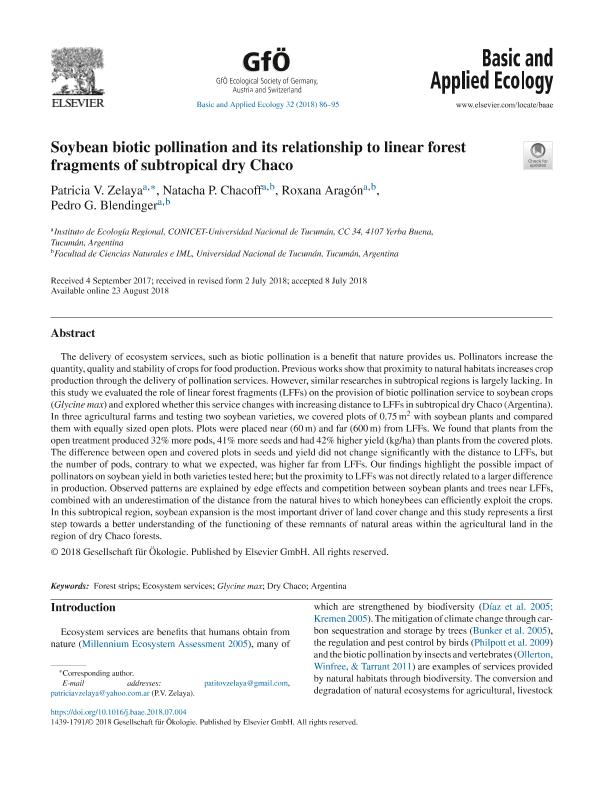Artículo
Soybean biotic pollination and its relationship to linear forest fragments of subtropical dry Chaco
Zelaya, Patricia Viviana ; Chacoff, Natacha Paola
; Chacoff, Natacha Paola ; Aragón, Myriam Roxana
; Aragón, Myriam Roxana ; Blendinger, Pedro Gerardo
; Blendinger, Pedro Gerardo
 ; Chacoff, Natacha Paola
; Chacoff, Natacha Paola ; Aragón, Myriam Roxana
; Aragón, Myriam Roxana ; Blendinger, Pedro Gerardo
; Blendinger, Pedro Gerardo
Fecha de publicación:
11/2018
Editorial:
Elsevier Gmbh, Urban & Fischer Verlag
Revista:
Basic and Applied Ecology
ISSN:
1439-1791
Idioma:
Inglés
Tipo de recurso:
Artículo publicado
Clasificación temática:
Resumen
The delivery of ecosystem services, such as biotic pollination is a benefit that nature provides us. Pollinators increase the quantity, quality and stability of crops for food production. Previous works show that proximity to natural habitats increases crop production through the delivery of pollination services. However, similar researches in subtropical regions is largely lacking. In this study we evaluated the role of linear forest fragments (LFFs) on the provision of biotic pollination service to soybean crops (Glycine max) and explored whether this service changes with increasing distance to LFFs in subtropical dry Chaco (Argentina). In three agricultural farms and testing two soybean varieties, we covered plots of 0.75 m2 with soybean plants and compared them with equally sized open plots. Plots were placed near (60 m) and far (600 m) from LFFs. We found that plants from the open treatment produced 32% more pods, 41% more seeds and had 42% higher yield (kg/ha) than plants from the covered plots. The difference between open and covered plots in seeds and yield did not change significantly with the distance to LFFs, but the number of pods, contrary to what we expected, was higher far from LFFs. Our findings highlight the possible impact of pollinators on soybean yield in both varieties tested here; but the proximity to LFFs was not directly related to a larger difference in production. Observed patterns are explained by edge effects and competition between soybean plants and trees near LFFs, combined with an underestimation of the distance from the natural hives to which honeybees can efficiently exploit the crops. In this subtropical region, soybean expansion is the most important driver of land cover change and this study represents a first step towards a better understanding of the functioning of these remnants of natural areas within the agricultural land in the region of dry Chaco forests.
Palabras clave:
ARGENTINA
,
DRY CHACO
,
ECOSYSTEM SERVICES
,
FOREST STRIPS
,
GLYCINE MAX
Archivos asociados
Licencia
Identificadores
Colecciones
Articulos(IER)
Articulos de INSTITUTO DE ECOLOGIA REGIONAL
Articulos de INSTITUTO DE ECOLOGIA REGIONAL
Citación
Zelaya, Patricia Viviana; Chacoff, Natacha Paola; Aragón, Myriam Roxana; Blendinger, Pedro Gerardo; Soybean biotic pollination and its relationship to linear forest fragments of subtropical dry Chaco; Elsevier Gmbh, Urban & Fischer Verlag; Basic and Applied Ecology; 32; 11-2018; 86-95
Compartir
Altmétricas



